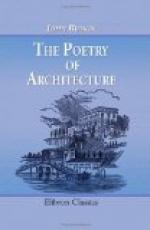67. Fig. 7, a, b and c are English chimneys. They are distinguishable, we think, at a glance, from all the rest, by a downright serviceableness of appearance, a substantial, unaffected, decent, and chimney-like deportment, in the contemplation of which we experience infinite pleasure and edification, particularly as it seems to us to be strongly contrasted with an appearance, in all the other chimneys, of an indefinable something, only to be expressed by the interesting word “humbug.” Fig. 7 a is a chimney of Cumberland, and the north of Lancashire. It is, as may be seen at a glance, only applicable at the extremity of the roof, and requires a bent flue. It is built of unhewn stones, in the same manner as the Westmoreland cottages; the flue itself being not one-third the width of the chimney, as is seen at the top, where four flat stones placed on their edges form the termination of the flue itself, and give lightness of appearance to the whole. Cover this with a piece of paper, and observe how heavy and square the rest becomes. A few projecting stones continue the line of the roof across the center of the chimney, and two large masses support the projection of the whole, and unite it agreeably with the wall. This is exclusively a cottage chimney; it cannot, and must not, be built of civilized materials; it must be rough, and mossy, and broken; but it is decidedly the best chimney of the whole set. It is simple and substantial, without being cumbrous; it gives great variety to the wall from which it projects, terminates the roof agreeably, and dismisses its smoke with infinite propriety.
[Illustration: FIG. 7. Chimneys.]
68. Fig. b is a chimney common over the whole of the north of England; being, as I think, one that will go well in almost any wind, and is applicable at any part of the roof. It is also roughly built, consisting of a roof of loose stones, sometimes one large flat slab, supported above the flue by four large supports, each of a single stone. It is rather light in its appearance, and breaks the ridge of a roof very agreeably. Separately considered, it is badly proportioned; but, as it just equals the height to which a long chimney at the extremity of the building would rise above the roof (as in a), it is quite right in situ, and would be ungainly if it were higher. The upper part is always dark, owing to the smoke, and tells agreeably against any background seen through the hollow.
69. Fig. c is the chimney of the Westmoreland cottage which formed the subject of the last paper. The good taste which prevailed in the rest of the building is not so conspicuous here, because the architect has begun to consider effect instead of utility, and has put a diamond-shaped piece of ornament on the front (usually containing the date of the building), which was not necessary, and looks out of place. He has endeavored to build neatly too, and has bestowed




